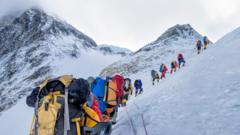In a move aimed at regulating the flow of climbers and increasing government revenue, Nepal has declared a boost in permit fees for those wishing to summit Mount Everest. Effective this September, climbers during the peak season will need to pay a new fee of $15,000 (£12,180), which marks a 36% increase from the previous rate of $11,000. Additionally, the costs for climbing outside of the peak months will see a similar rise: $7,500 from September to November, and $3,750 from December to February.
The rise in permit fees comes as a response to ongoing criticism directed at the Nepalese government for the overcrowding issues occurring on Everest. Annually, nearly 300 permits are issued for climbers attempting the ascent. Narayan Prasad Regmi, the director general of the Department of Tourism, acknowledged that the fee structure had been stagnant for too long and is necessary for updating the system. However, he did not mention how the additional revenue would be allocated.
In April 2024, the Supreme Court of Nepal mandated the government to reduce the number of climbing permits issued to mitigate the pressures of overcrowding, although a specific limit has yet to be established. Social concerns around climbers queuing in perilous conditions to reach the top have prompted further scrutiny of the climbing process. This concern has led to initiatives such as the Nepalese army's annual clean-up operations on Everest, which have, to date, removed over 119 tonnes of waste and several human remains, yet many bodies are still believed to remain on the mountain.
Nepal's economic landscape heavily relies on tourism, particularly through mountain climbing, with this sector accounting for more than 4% of the nation’s income. This increase in permit fees may have significant implications for the industry as it strives to balance economic gain with environmental preservation.
The rise in permit fees comes as a response to ongoing criticism directed at the Nepalese government for the overcrowding issues occurring on Everest. Annually, nearly 300 permits are issued for climbers attempting the ascent. Narayan Prasad Regmi, the director general of the Department of Tourism, acknowledged that the fee structure had been stagnant for too long and is necessary for updating the system. However, he did not mention how the additional revenue would be allocated.
In April 2024, the Supreme Court of Nepal mandated the government to reduce the number of climbing permits issued to mitigate the pressures of overcrowding, although a specific limit has yet to be established. Social concerns around climbers queuing in perilous conditions to reach the top have prompted further scrutiny of the climbing process. This concern has led to initiatives such as the Nepalese army's annual clean-up operations on Everest, which have, to date, removed over 119 tonnes of waste and several human remains, yet many bodies are still believed to remain on the mountain.
Nepal's economic landscape heavily relies on tourism, particularly through mountain climbing, with this sector accounting for more than 4% of the nation’s income. This increase in permit fees may have significant implications for the industry as it strives to balance economic gain with environmental preservation.























